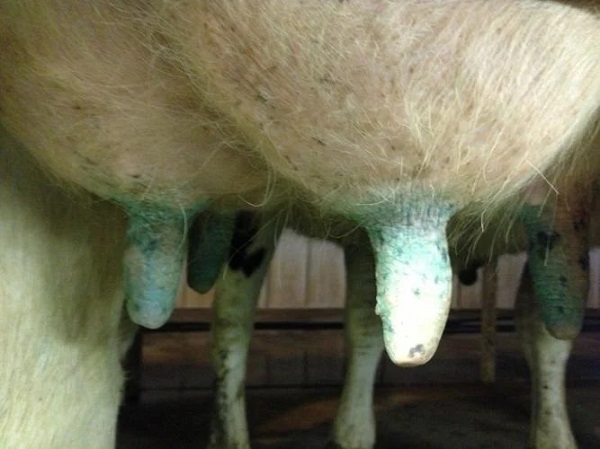
Cooler temperatures reduce much of the stress faced by dairy cattle but bring more challenges with teat condition. As the temperature drops it is more difficult to maintain skin moisture, leading to chapping. Just as chapped, bleeding hands are painful for us, teat chapping is equally irritating for cattle. Discomfort from this chapping makes udder prep and milking itself painful for the animal. Not surprisingly these animals may respond with additional kicking and milk letdown can be reduced.
Cracks in teat skin may emerge on the teat barrel or teat end. Cracked teats create the ideal environment for bacteria to hide and proliferate; these bacteria have the potential to migrate into the udder where new infections may emerge. Research also shows certain viruses (herpes and pseudocowpox) thrive in cold temperatures. These viruses can produce lesions on teat ends which at first glance may appear to be from chapping or milking system problems (high vacuum). Now is the time to prepare to prevent adverse effects on teat condition from cold weather.
Keep these points in mind as we head into winter:
Provide clean, dry housing and protection from wind to reduce the number of new environmental infections. This is probably the best way to ensure good teat condition throughout the winter.
Restrict access to potentially muddy areas to keep udders clean and reduce damage from prolonged wetness. Temporary fencing can be used to exclude cattle from these areas.
Secure sufficient bedding to keep stalls well bedded. Check with bedding suppliers now to gauge estimated availability during winter months. If storage space is adequate, taking extra loads now is advised. It may be necessary to make arrangements for alternative bedding sources if supply is anticipated to be tight.
Evaluate the emollient level of your teat dip. Higher emollients are needed in the winter to retain skin moisture and assist with healing of chapped teats. Glycerin levels of 5 to 10 percent are common in winter post dips. Higher levels of emollient are especially important for cattle with limited shelter from wind and weather.
Make sure milking systems are functioning properly. Teats that are already stressed from winter weather can be further compromised by poorly functioning milking equipment. Check operation of pulsators and make sure vacuum levels are in a normal range.
Remix dip if it becomes frozen. The active ingredients in teat dips can settle out if frozen. It is important to remix these before use or the concentration of the dip will be too low near the top of the barrel and too strong at the bottom.
Keep using post dip. Although it may be tempting to stop using teat dip during cold conditions, this can make problems worse. Contagious mastitis organisms (such as Staph aureus) can spread when post dipping is stopped. Post dipping can also control the spread of viruses that cause teat lesions. Emollients in the dip also aid in recovery of chapped teats. During very cold periods (-15°F with wind chill), consider applying post dip, allowing 30 seconds contact time, and wiping dry to prevent frozen teats.
Provided by Beverly Cox, Virginia Cooperative Extension, Virginia Tech and Virginia State University
Related Articles & Free Email Newsletter Sign Up
How to Identify and Treat BVDV in Livestock
Proper Prepping of Dairy Cattle Leads to Better Milk Production




Comment here